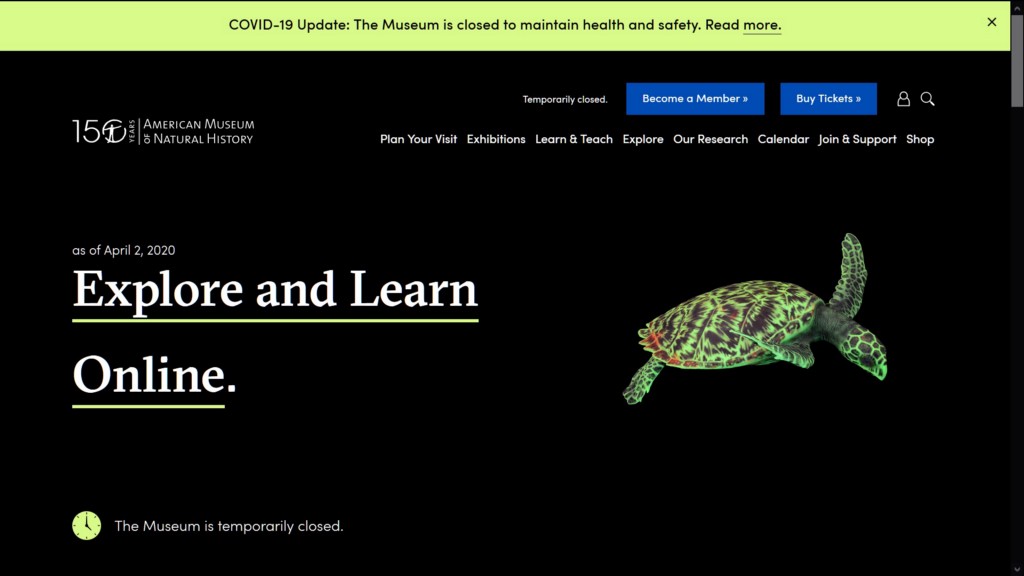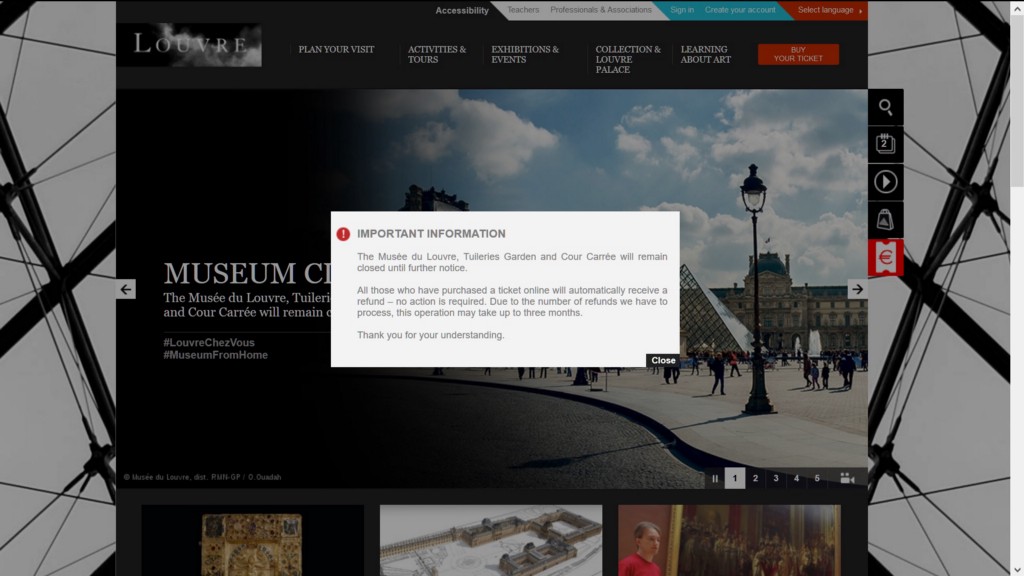
Beacons in the Dark
April 22, 2020 - All
How Museums are Keeping their Collections Open while the World is Closed
Just a few months ago, none of this seemed possible, or even imaginable. While we were all still enjoying our winter holidays and celebrating the start of a new year, the first wave of patients in China were already being treated for an insidious infection that would become known around the globe as COVID-19. As 2020 got off the ground, so did the virus, being carried unknowingly aboard airplanes, ships and trains, and spreading to nearly every continent on the planet. Enduring much grief and consternation, the entire world has been gripped by this outbreak, and life for just about everyone has been turned upside down. Quarantines, shutdowns, and self-imposed isolation have become the new norm for many of us, while thousands of first responders and medical personnel have been heroically working around the clock to stem the tide of this deadly disease.
We can only hope that the end to this surreal crisis is drawing near, but the lingering uncertainty over when that day will arrive can sometimes be the most difficult aspect to endure. Rather than succumb to the situation, many major museums are finding a way to help keep society safely engaged with their collections, despite the distancing.

At the American Museum of Natural History’s website, for example, there is a robust offering of complimentary digital tools catering to educators, families and casual visitors kept away by the shutdown. There are games, videos and an extensive virtual tour made possible through cooperation with Google Arts & Culture. In addition, AMNH hosts Facebook Live watch parties twice a week which sometimes feature museum tour guides highlighting a variety of exhibits from selected halls while sharing their insight with thousands of viewers. Other streams included explorations of the Universe or deeper dives into the specimen collections of AMNH, all with the ability to receive live feedback from their audience while broadcasting online. A history of past watch parties are also available to replay, with the available selections constantly expanding as the museum continues to engage with the shuttered world digitally, and welcomes all virtual visitors to freely enjoy and share their content.
Producing such valuable material at a time when it is impossible for museums to generate any revenue from foot traffic is a great gesture of goodwill, and other institutions have demonstrated similar generosity. In France, the Louvre has enacted a policy to automatically refund all online ticket purchases that have been impacted by the mandatory closures. Their popular “Mona Lisa Beyond the Glass” Virtual Reality Experience and “VR — Mona Lisa” App are also both currently available to download for free on a variety of devices. These digital engagements are quite immersive and are capable of creating a uniquely intimate encounter with the artwork. Though it may not be quite the same as visiting da Vinci’s painting in person, there are certainly worse ways to pass the time while sequestered at home.

Another centuries-old European landmark has been keeping people busy through some lively social media engagement. With Adam Koszary at the helm, Britain’s Royal Academy of Arts’ Twitter account has been sharing fun facts about their collection, virtual tours of exhibitions and a very amusing daily doodle challenge. Inviting followers to offer their best artistic interpretations of sloths, thirsty ferrets and even a cooked ham, Mr. Koszary has proven himself quite successful at injecting some much needed levity into our current sobering solitude. During a recent interview with The New York Times, he explained his approach toward using the Royal Academy’s online presence and offered some advice to his peers:
“A lot of people are going to fall into the trap of just trying to give people what they’d come to see in person on the screen,” Mr. Koszary said, “but social media doesn’t work like that. It’s meant to be collaborative, democratic.”
That needed to be realized especially as the pandemic gets worse, he said. “Arts and heritage can’t possibly fix coronavirus, but we can try and do something to help the sadness and fear.”
His two main points are quite profound, the idea that interactions between institutions and their isolated visitors must be a collaborative endeavor, not merely a one-way flow of content, and that despite the inability of GLAM entities to directly combat a contagious outbreak, they are invaluable in assuaging the fears and anxiety of those affected communities they are still able to connect with.
That sense of digital connection amidst our physical separation is of great comfort to millions of people around the world right now, and Facebook groups such as Emerging Museum Professionals play an integral role. Not only do members exchange inventive ideas and projects to help pass the time, but there is a good deal of personal outreach assessing the emotional climate of the community and offering support to those seeking it out. Scrolling through the assorted posts, I was reminded of the words of The Met’s Director Max Hollein in one of his recent updates on their current situation:
“. . . I want to emphasize that despite the challenges we are facing now, the Museum is a strong, active, and engaged institution. In the uncertain days still to come, I have no doubt that museums will continue to perform an invaluable role in lifting spirits, preserving local and international cultures, helping us interpret the world we live in, and bringing together diverse communities, giving us all a sense of solidarity and shared humanity. We hope that you are heartened, as we are, by these tributes to the endurance of the human creative spirit.”
These words have lingered in my mind as I continue to explore the varied responses museums have enacted in the face of this terrible pandemic. While many institutions around the globe have adopted their own unique approach to dealing with the crisis, they are united in their mission to keep collections accessible while the world is closed, and continue to endure as beacons of cultural heritage in these dark and discouraging times.
Sources
Emerging Museum Professionals. (n.d.). Retrieved April 5, 2020, from https://www.facebook.com/groups/nempn/?notif_id=1585792069896839¬if_t=group_r2j_approved
Marshall, A. (2020, March 30). Museum World’s King of Memes Brings Humor to Lockdown. The New York Times. https://www.nytimes.com/2020/03/30/arts/design/museums-coronavirus-adam-koszary.html
Beacons in the Dark was originally published in Museums and Digital Culture – Pratt Institute on Medium, where people are continuing the conversation by highlighting and responding to this story.